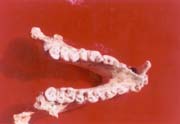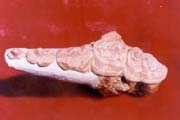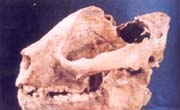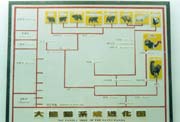|
 In the evolutionary history of animals and in the competition of survival, the giant panda has already been one of the winners. In the evolutionary history of animals and in the competition of survival, the giant panda has already been one of the winners.
Analysis over already found fossils indicates that, in late Miocene that is about 8 million years ago, at the edge of the tropical humid forest around the Lufeng Area in Yunan Province of China, there had lived the ancestor of giant panda - The primal panda (Ailuaractos Lufengensis), which is the earliest panda that evolved from arctoid with a carnassial food habit. The figure of the primal panda is like a fat fox. The lineage evolved from the primal panda is Agriarcros Goaci, which had been inhabiting in the humid forest around Hungary and France in Europe. The primal panda became extinct in late Miocene period. While the main lineage of primal giant panda continued their evolution in central and south China, one branch of which appeared in early Pleistocene about 3 million years ago, was half the size of the giant panda that we see today, mostly like a fat dog. The fossil of this branch is named as Ailuropoda Micrta. From the fossil teeth of the Ailuropoda micrta, it is speculated to have evolved into a species of omnivorous animals which partially feed on bamboos. Two million years later, these smaller-figured giant pandas started to extend their living areas to the sub-tropical humid forest, which gradually covered the former living areas of primal pandas around Yunnan, Guangxi and Sichuan. Later on, the giant panda has further adapted to the life in subtropical bamboo woods and their bodies grew bigger and bigger. In age of mid and late Pleistocene, which is between the 500 thousand to 700 thousand years ago, was the flourishing age of giant pandas. The figure of the fossil Ailuropoda Milanoleuca Wulishansis is only 1/8 smaller than that of present giant panda. However, till the late Pleistocene Period, the figure of the fossil Ailuropoda Milanoleuea Daconi, which had been living on bamboo, became about 1/8 bigger than that of present giant panda.
 
 

Giant Panda- Stegodon Sinensis
|